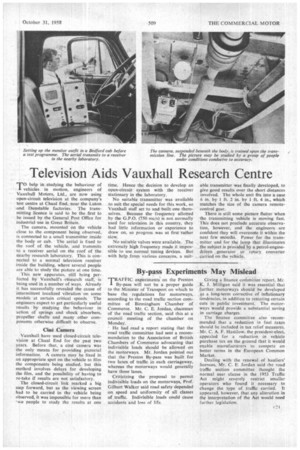Television Aids Vauxhall Research Centre
Page 57

If you've noticed an error in this article please click here to report it so we can fix it.
TO help in studying the behaviour of vehicles in motion, engineers of Vauxhall Motors, Ltd., are now using open-circuit television at the company's test centre at Chant End, near the Luton .and Dunstable factories. The transmitting licence is said to be the first to be issued by the General Post Office for industrial use in Great Britain.
The camera, mounted on the vehicle close to the component being observed, is connected to a small transmitter inside the body or cab. The aerial is fixed to the roof of the vehicle, and transmits to a receiver aerial on the roof of the nearby research laboratory. This is connected to a normal television receiver inside the building, where several people are able to study the picture at one time.
This new apparatus, still being perfected •by Vauxhall's research staff, is being used in a number of ways. Already it has successfully revealed the cause of intermittent localized vibration on some models at certain critical speeds, The engineers expect to get particularly useful results by studying the behaviour in action of springs and shock absorbers, propeller shafts and many other cornponents otherwise difficult to observe.
Cine Camera Vauxhall have used closed-circuit television at Chaul End for the past two years. Before . that, a ciné camera was the only means for providing pictorial information. A camera may be fixed in an appropriate spot on the vehicle to film the components being studied, but this method involves delays for developing the film, and the possibility of having to re-take if results are not satisfactory.
The closed-circuit link marked a big step forward, but as the viewing screen had to be carried in the vehicle being observed, it was impossible for more than .wo people to study the results at one
time. Hence the decision to develop an open-circuit system with the receiver stationary in the laboratory.
No suitable transmitter was available to suit the special needs for this work, so Vauxhall staff set to and -built one themselves, Because the frequency allotted
• by the G.P.O. (750 tnc/s) is not. normally used for television in this country, they had little information or experience to draw on, so progress was at first-rather slow.
No suitable valves were available. The extremely high frequency made it impossible to use normal tuning devices. But with help from various concerns, a suit able transmitter was finally developed, to give good results over the short distances involved. The whole unit fits into a case 6 in. by 1 ft. 2 in. by 1 ft. 4 in., which matches the size of the camera remotecontrol gear.
There is still some picture flutter when the transmitting vehicle is moving fast. This does not preclude accurate observation, however, and the engineers are confident they will overcome it within the next few months. Power for the transmitter and for the lamp that illuminates the subject is provided by a petrol-enginedriven sgenerator or rotary converter carried on the vehicle.
































































































